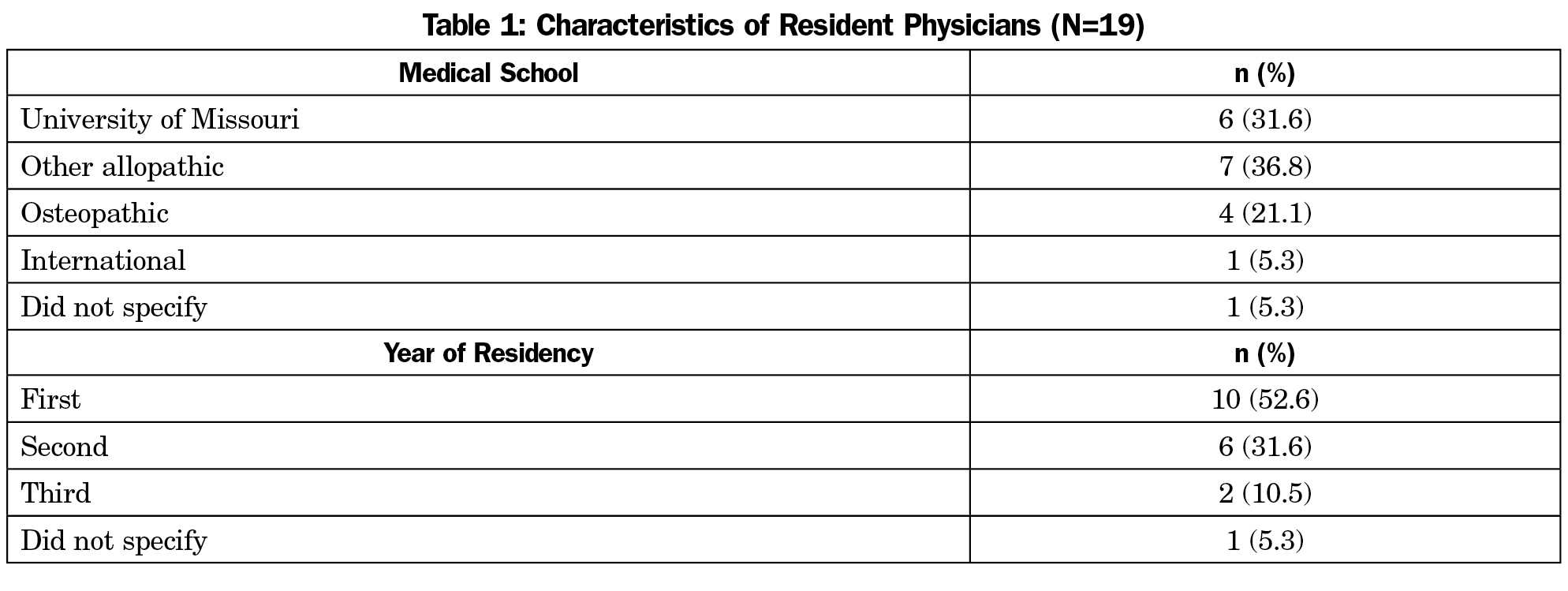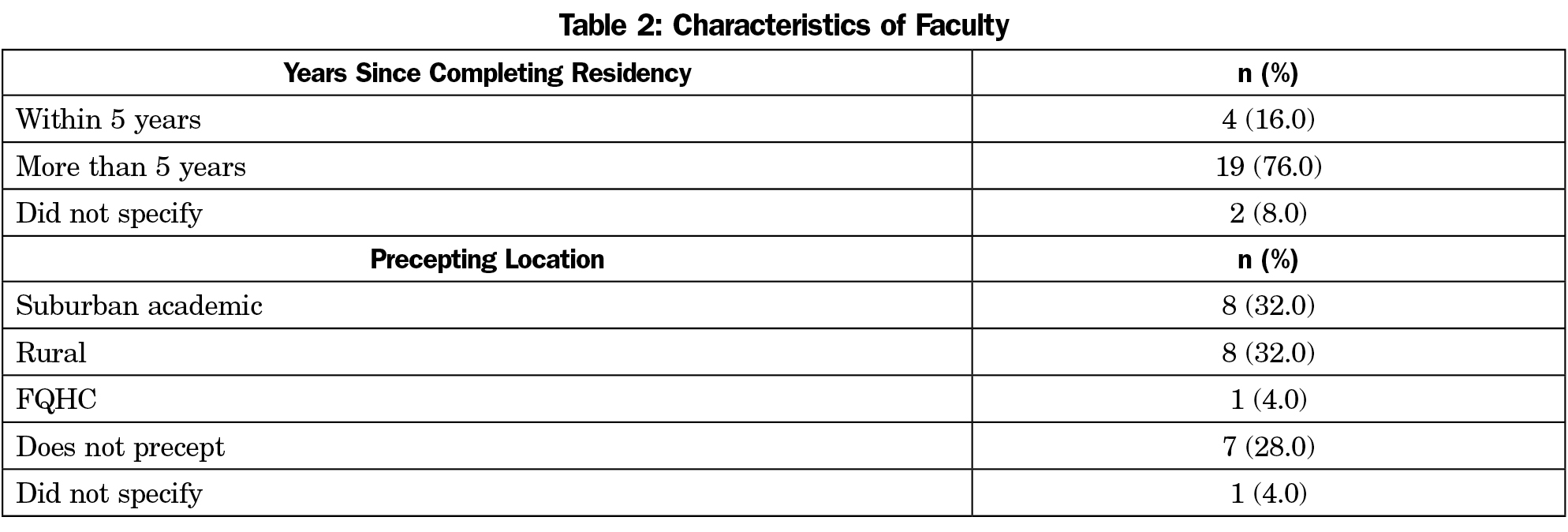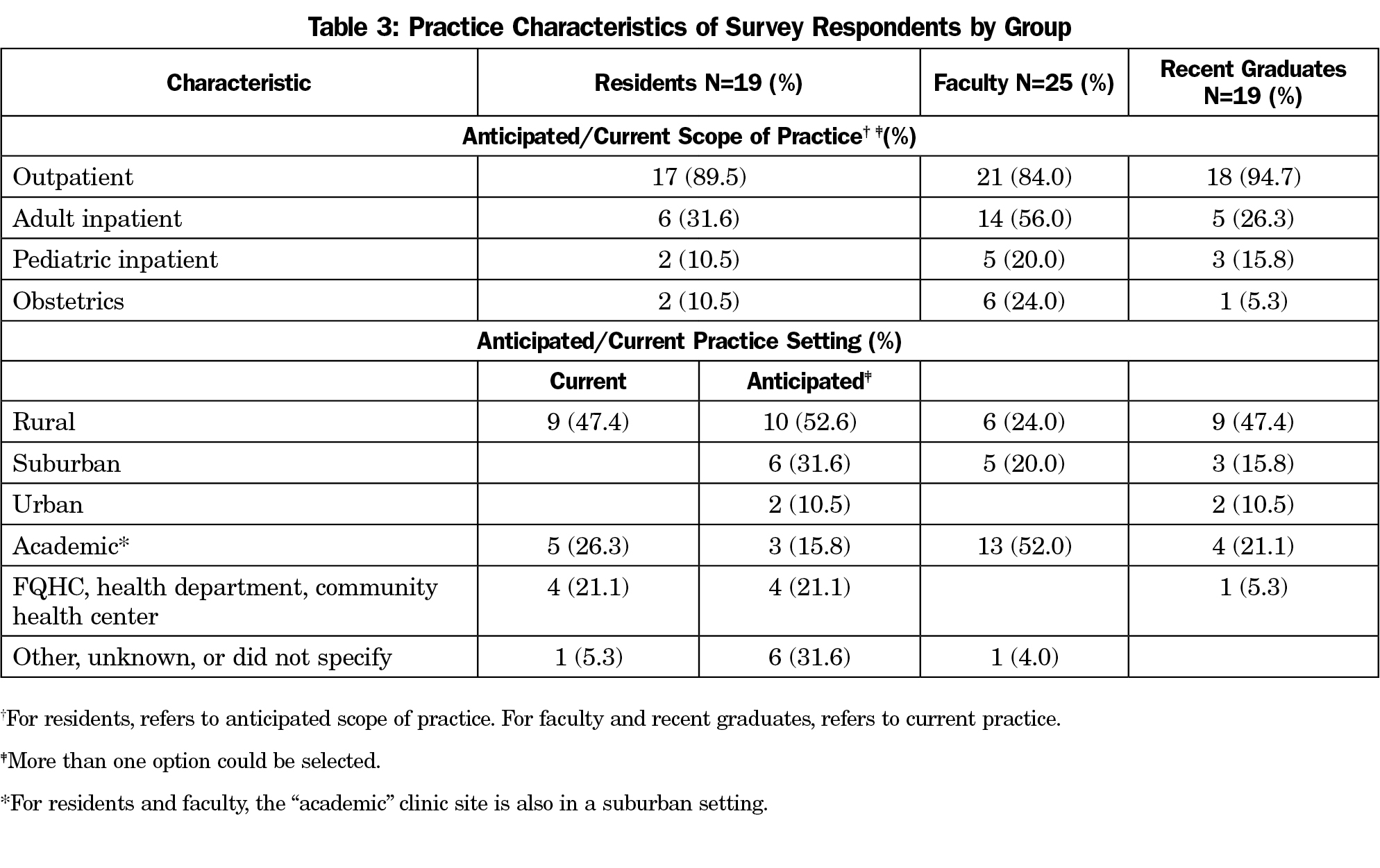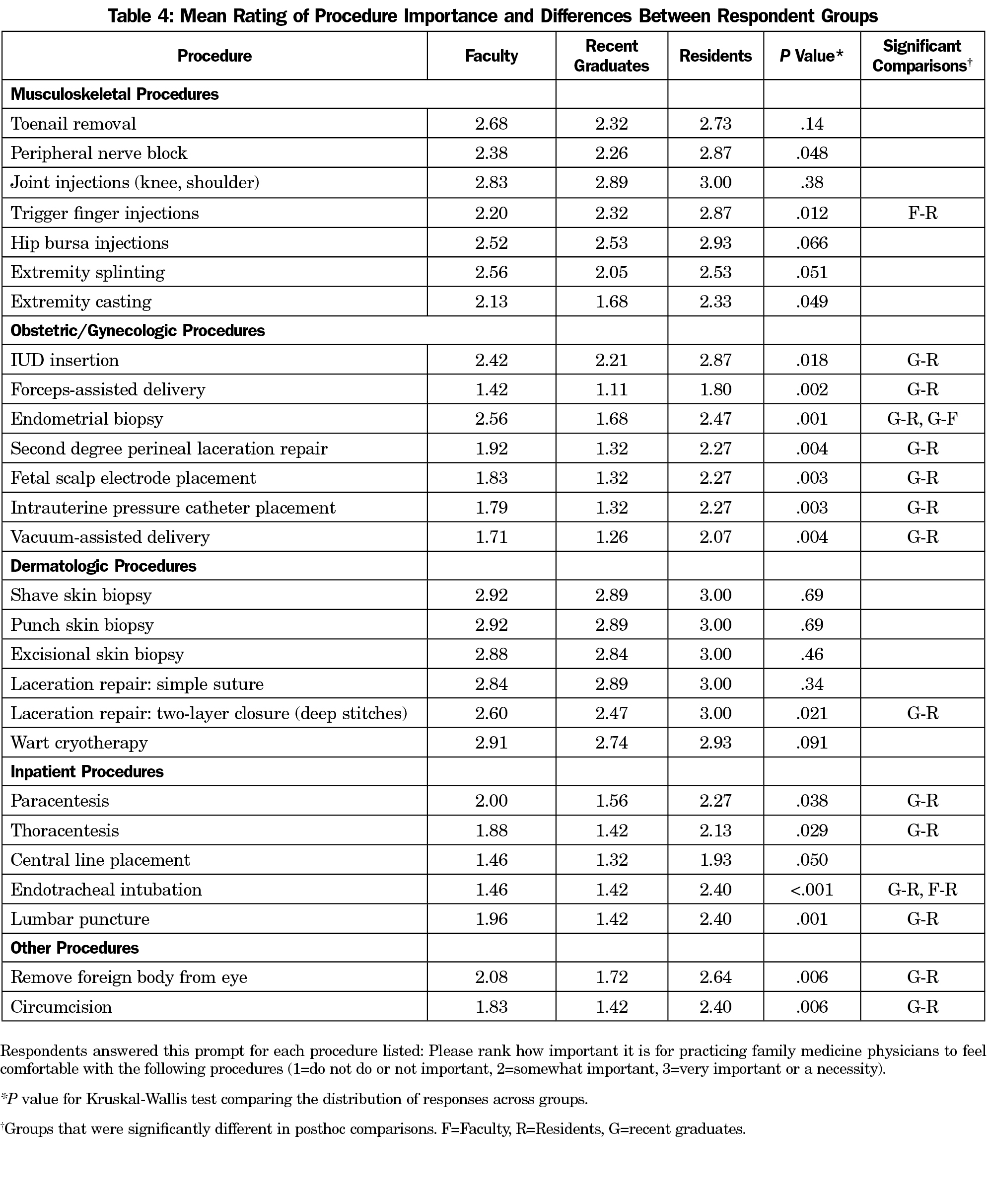Advanced Procedural Training in Family Medicine: a Group Consensus Statement
Abstruse
Background and Objectives: Procedural training is integral to family medicine residencies. Although accreditation bodies require that family medicine residency programs train residents in procedures relevant to their practices, there are no standards defining the scope of family medicine. We compared the perceived importance of 31 procedures by kinesthesia, residents, and recent graduates of one institution.
Methods: An online survey was sent to current residents and faculty of a large academic family medicine residency, every bit well every bit customs practitioners who had graduated from that residency within the past 5 years. The survey asked participants to charge per unit how important 31 procedures are for family unit medicine practices.
Results: The overall response charge per unit was 37%. Most respondents provided outpatient care, and few provided or intended to provide obstetric care. Dermatologic and musculoskeletal procedures were rated as having high importance by all groups, whereas obstetric and inpatient procedures received lower ratings. Residents ascribed higher importance than faculty or recent graduates for nearly all procedures.
Conclusions: Most residents, faculty, and customs practitioners provided outpatient care and rated dermatologic and musculoskeletal procedures equally important. Inpatient and obstetric intendance are less mutual career paths, and related procedures were rated as less important. Resident physicians ascribed greater importance than community practitioners for many procedures, which may be due misperceptions of their future do needs or imposed requirements for graduation.
Decisions regarding which procedures to emphasize in family medicine preparation nowadays an ongoing challenge. The Accreditation Council for Graduate Medical Education mandates that family unit medicine residents "receive training to perform clinical procedures required for their hereafter practices" without specific guidelines.1 Consensus statements by the Quango on Academic Family Medicine and the Order of Teachers for Family unit Medicine Group on Hospital Medicine and Procedural Training list recommended procedures.2,3 These lists are considered a starting bespeak, as programs currently develop their ain process requirements.
Procedures performed by family doctors vary past geography, demography, and setting. Rural providers may perform more procedures than doctors in urban settings.four-half dozen Men may perform more procedures than women,5,6 except for gynecologic procedures.seven A national survey revealed that the most common procedures performed by family unit doctors are skin procedures (73.iv%), musculoskeletal injections (64.2%), spirometry (34.three%), and endometrial sampling (xxx.0%).eight The telescopic of family do is decreasing besides. A contempo survey revealed that less than 50% of chief residents plan to do obstetrics.5 Surveys of graduates from the Academy of Missouri Family unit and Community Medicine (MUFCM) residency program reveal that the number of graduates practicing obstetrics, inpatient medicine, critical intendance, or emergency medicine has decreased.5,9
MUFCM recently revised its procedure curriculum, bookkeeping for residents' goals and likely needs. We conducted a survey to document practice patterns and determine the most important procedures co-ordinate to residents, faculty, and customs practitioners.
Methods
The MUFCM residency is a 12/12/12 program. Residents see patients at one of four sites—2 rural clinics, ane suburban clinic, and one federally qualified health center. Faculty have continuity clinics at these same locations and ii boosted suburban clinic sites. MUFCM residents rotate on mandatory family medicine inpatient and obstetric services. They are required to perform articulation injections, laceration repairs, peel biopsies, circumcisions, vaginal deliveries, and one toenail removal. Faculty may see patients and supervise residents in clinic, on adult or pediatric inpatient services, or obstetric services.
We adult an online Qualtrics survey to assess perceptions of the importance of 31 outpatient, inpatient, pediatric, and obstetric instrument-assisted procedures. Prior to distribution, a faculty panel verified face validity. Respondents rated procedures' importance as: 1=do not do (faculty and community practitioner only) or not important, 2=somewhat important, and 3=very of import or a necessity. Nosotros also nerveless information regarding demographics, do location, and setting.
The survey was emailed to all current MUFCM residents and faculty, as well equally physicians who graduated from MUFCM residency within 5 years and are at present employed elsewhere (hereafter, "recent graduates"). 1 reminder e-mail was sent to all participants. Responses were anonymous, participation was voluntary, and no incentives were offered.
Survey data were downloaded and imported into SAS for Windows 9.4 (SAS Institute, Cary, NC). Nosotros calculated hateful responses for each category. Considering data were ranked, we used the Kruskal-Wallis test to determine whether responses were from the same distribution. Posthoc tests were performed between groups when the initial test was statistically significant and were adjusted by the Bonferroni correction to account for multiple tests. This study was exempted by the Academy of Missouri Health Sciences Institutional Review Board.
Results
The overall response rate was 37%. Nineteen of 36 residents (53%) responded to the survey (Tabular array one). Over half of residents who responded were in their first year. Approximately one-third of residents attended medical schoolhouse at the Academy of Missouri, and i-tertiary attended some other allopathic program. Twenty-5 of 89 kinesthesia (29%) and 19 of 47 recent graduates (40%) responded. Virtually faculty completed residency more than v years ago (Table 2).
Half of residents and recent graduates expert in a rural location (Tabular array 3). Most residents anticipated practicing in rural locations. Most faculty proficient in a suburban setting. All the same, all 3 groups reported higher percentages of rural practice compared to national averages. x In all three cohorts, nigh respondents practiced or predictable practicing outpatient medicine. Fewer practiced or anticipated practicing adult inpatient medicine. Obstetrics and pediatric inpatient medicine were the least frequently endorsed.
All cohorts rated musculoskeletal and dermatologic procedures as highly of import (Table 4). Obstetric and inpatient procedures were rated as less important, especially among recent graduates. Residents ascribed higher importance than faculty or contempo graduates for all procedures except extremity splinting and endometrial biopsy. Statistically significant differences between ratings of procedure importance were seen for every obstetric and gynecologic process, with residents ascribing highest importance and recent graduates ascribing lowest importance. Similar findings were seen for all inpatient procedures listed except for central line placement, for which all groups assigned depression importance.




Discussion
Our written report shows that residents consistently rated procedures, especially inpatient and OB procedures, as more important than contempo graduates. Although non statistically pregnant, resident physicians besides consistently rated procedures as more important compared to faculty. Residents may be unaware of factors that may shape their future practice. All residents, merely non all faculty, serve on inpatient and obstetric services, which may influence residents' perceptions.
All groups rated outpatient dermatologic and musculoskeletal procedures as highly important and obstetric and inpatient procedures as less important. Office-based procedures appear to have higher priority. Recent graduates may be influenced past local demography, cost of supplies, fiscal reimbursement, contest with specialists, or may feel limited by their residency grooming. Kinesthesia may limit procedures due to time constraints or competing professional obligations. Residents may exist influenced by faculty function models.
The scope of family practise, including procedural practice, appears to be narrowing. A 2014 national survey of newly-certifying and recertifying family physicians showed that new graduates conceptualize providing a broader scope of do than electric current practitioners.xi Despite early ambitions to provide full-telescopic care, telescopic of practice—including inpatient, obstetrics, and procedures—narrows shortly after residency. Further written report is needed to decide how competition with subspecialists, physician reimbursement, or residency training influence the scope of family medicine practice.
The study is express by the number of respondents. Few third-twelvemonth residents responded, and first-year residents may take less understanding of their future do needs. Dissimilar faculty practice locations may influence the procedures washed in their private clinics. Furthermore, our survey was distributed to physicians currently or previously employed by one establishment and may not generalize to other programs.
Nevertheless, it is notable that nosotros found differences regarding procedure importance betwixt current residents and recent graduates of the aforementioned institution. This study is unique in that information technology surveys learners, faculty, and recent graduates to brainstorm to decide the types of procedures valuable for family medicine. As accreditation bodies reassess procedural grooming, they may consider whether residencies should encourage full-scope practice or focus on common practise trends. For individual programs, it may be worthwhile to consider practise patterns of graduates as a starting point. More investigation is recommended to brand procedure preparation more relevant.
Acknowledgments
Presented at the Academy of Missouri, Section of Family and Community Medicine, June 14th, 2017.
References
- Accreditation Council for Graduate Medical Education. ACGME Program requirements for graduate medical education in family unit medicine. Effective July one, 2017. https://www.acgme.org/Portals/0/PFAssets/ProgramRequirements/120_family_medicine_2017-07-01.pdf?ver=2017-06-thirty-083354-350. Accessed Oct 11, 2017.
- Association of Family unit Medicine Residency Directors. CAFM consensus statement for procedural grooming in family medicine residency. https://afmrd.socious.com/folio/procedures. Accessed March 29, 2017.
- Kelly BF, Sicilia JM, Forman Due south, Ellert W, Nothnagle M. Advanced procedural preparation in family unit medicine: a group consensus statement. Fam Med. 2009;41(six):398-404.
- Goertzen J. Learning procedural skills in family medicine residency: comparison of rural and urban programs. Can Fam Physician. 2006;52:622-623.
- Precipitous LK, Wang R, Lipsky MS. Perception of competency to perform procedures and futurity practice intent: a national survey of family practise residents. Acad Med. 2003;78(9):926-932. https://doi.org/10.1097/00001888-200309000-00019.
- Tucker W, Diaz 5, Carek PJ, Geesey ME. Influence of residency grooming on procedures performed past South Carolina family medicine graduates. Fam Med. 2007;39(10):724-729.
- MacKenzie MS, Berkowitz J. Practise procedural skills workshops during family practise residency piece of work? Can Fam Doctor. 2010;56(viii):e296-e301.
-
American University of Family Physicians. Table 14: Clinical procedures performed by physicians at their practise. https://world wide web.aafp.org/nigh/the-aafp/family-medicine-facts/tabular array-12(rev).html. Accessed Oct 11, 2017.
- Ringdahl Eastward, Delzell JE Jr, Kruse RL. Changing practice patterns of family medicine graduates: a comparison of alumni surveys from 1998 to 2004. J Am Lath Fam Med. 2006;xix(4):404-412. https://doi.org/10.3122/jabfm.19.4.404.
-
American Academy of Family Physicians. Table ii: Demographic characteristics of AAFP members. https://www.aafp.org/most/the-aafp/family unit-medicine-facts/table-two.html. Accessed Dec 19, 2017.
- Coutinho AJ, Cochrane A, Stelter 1000, Phillips RL, Jr., Peterson LE. Comparison of intended telescopic of practice for family medicine residents with reported telescopic of practice amid practicing family physicians. JAMA. 2015;314(22):2364-2372. https://doi.org/ten.1001/jama.2015.13734.
Source: https://journals.stfm.org/familymedicine/2018/june/ludden-schlatter-2017-0374
0 Response to "Advanced Procedural Training in Family Medicine: a Group Consensus Statement"
Postar um comentário